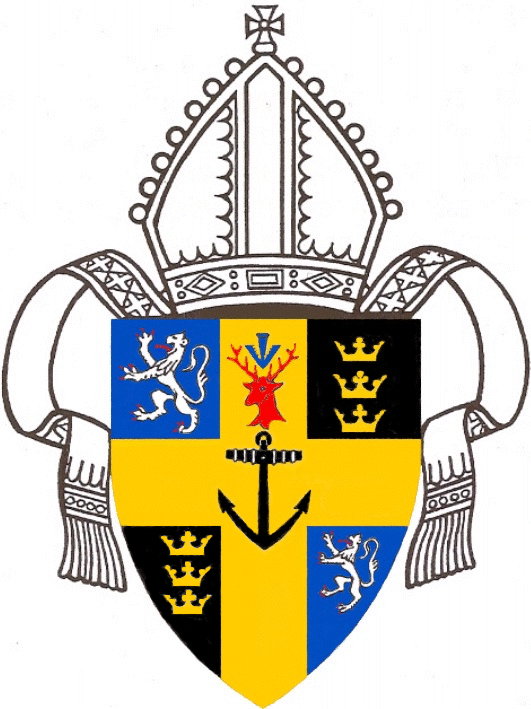
DIOCESE OF CAPE TOWN, Anglican Church of Southern Africa.[1]
Diocese established in 1847.
Cathedral: St George the Martyr, Cape Town.
Archbishop’s residence: Bishop’s Court, Wynberg.

Arms granted by the College of Arms under Letters Patent dated 25 January 1952 and registered with the Bureau of Heraldry under Certificate No 458, dated 6 January 1972. The blazon reads:
Quarterly, azure and sable:
I and IV, a lion rampant argent; II and III: three open crowns palewise or; on a cross throughout also or, an anchor in fess point sable and in honour point a stag’s head erased, gules, between the attires a pheon azure.
These arms differ in one significant detail from the arms originally adopted by the diocese under its first bishop, Robert Gray. To see those arms, see here.
The entry in Brownell’s book[2] reads:
“This is a simplified version of the arms borne by the diocese from 1847-51. The only significant difference is the substitution of the escutcheon of Burdett-Coutts, which appeared at honour point in the earlier version, by the stag’s head and pheon, the principal charges in the Coutts arms.
“In the registers of the College of Arms, the stag’s head in the arms of Angela Burdett-Coutts is correctly blazoned as ‘erased’, but incorrectly depicted as ‘caboshed’. The use of the erased stag’s head as a simplified charge in the diocesan arms thus corrects an earlier artistic error.”
About the diocese:
With the creation of the dioceses of George and of Kimberley and Kuruman in 1911, the Diocese of Cape Town assumed a geographical shape that it would keep until the end of the 20th century: it encompassed the entire West Coast of the Cape Province and part of the southern coast as far as the Breede River mouth.
One notable exception was made to include a parish 2 816 km west-south-west of Cape Town: the island of Tristan da Cunha. Although part of the Colony of St Helena, the island lacked regular communication with Jamestown as ships sailed between the two islands far too irregularly. Instead, the island was not only provisioned from Cape Town, but its rector also was provided by that diocese.
This situation only changed in 1990, when the MV St Helena began paying regular annual calls to Tristan. Since then the island has reverted to the jurisdiction of the Bishop of St Helena.
Only in 2005 was the Cape Town diocesan area significantly reduced with the creation of the Diocese of False Bay, followed in 2008 by the Diocese of Saldanha.
The diocese maintains its own website here.
Archbishops: When the current arms were adopted in 1952 the archbishop was Geoffrey Clayton (consecrated 1948). His successors have been Joost de Blank (1957), Robert Selby Taylor (1964, previously bishop of Lusaka, Pretoria and Grahamstown), Bill Burnett (1974, previously Bishop of Grahamstown), Philip Russell (1981, previously Bishop of Natal and first Bishop of Port Elizabeth), Desmond Tutu (1986, previously Bishop of Lesotho and Bishop of Johannesburg) and currently Archbishop Emeritus), Njongonkulu Ndungane (1996) and Thabo Makgabo (2008, previously Bishop of Grahamstown).
Languages: The Anglican community of the Cape Town diocesan area speaks chiefly Afrikaans, English and Xhosa. The diocese uses all three in worship and administration.
